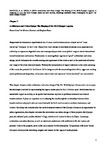Architecture and Urban Design: The Shaping of Rio 2016 Olympic Legacies
| dc.contributor.author | Latuf de Oliveira Sanchez, R | |
| dc.contributor.author | ESSEX, Stephen | |
| dc.contributor.editor | Zimbalist A | |
| dc.date.accessioned | 2017-11-07T10:11:19Z | |
| dc.date.available | 2017-11-07T10:11:19Z | |
| dc.date.issued | 2017-09-14 | |
| dc.identifier.isbn | 978-0-8157-3245-7 | |
| dc.identifier.other | 5 | |
| dc.identifier.uri | http://hdl.handle.net/10026.1/10133 | |
| dc.description.abstract |
Megaevents have become a significant driver of urban transformation and an integral part of “place marketing” strategies for host cities. Many cities have attempt to take these occasions as an opportunity to redevelop or regenerate degraded areas and consequently promote a new global image to attract international inward investment and tourism. Fundamental to securing these legacies is “good” architecture and urban design, which influences the smooth running and appearance of the event as well as the postevent utilization and image of the event sites and venues. Without the incorporation of legacy outcomes in the initial planning of the event, the potential for facilities to fail to integrate with the surrounding urban fabric, aggravate existing social problems and disparities, or become underutilized and expensive “white elephants” are considerable. This chapter focuses on the architecture and urban design of the Rio 2016 Olympic Games and aims to assess the challenges involved in implementing the legacy master plan for Rio’s Olympic park. Architecture has an undeniable impact on society, as its spatial interventions may lead to profound economic and cultural transformations. It plays an important role in shaping the city through the relationship between urban transformations and people who are associated with the built environment as residents, businesses, and visitors. By taking into consideration the much-discussed context of the Olympic Games as an opportunity for urban regeneration, this chapter evaluates the architecture and urban design of three projects: the Olympic park, the athletes’ park, and the athletes’ village, which are all located in Barra da Tijuca. Landscape architecture and urban theories, as well as interviews undertaken with architects in Rio de Janeiro and personal visits to the projects, serve as the main sources for this discussion. Comparisons with some former Olympics cities provide interesting insights and lessons for the legacy of such projects. | |
| dc.format.extent | 9 | |
| dc.format.extent | 97-120 | |
| dc.language.iso | en | |
| dc.publisher | Brookings Institution Press | |
| dc.relation.ispartof | Rio 2016: Olympic myths, hard realities | |
| dc.title | Architecture and Urban Design: The Shaping of Rio 2016 Olympic Legacies | |
| dc.type | chapter | |
| plymouth.publisher-url | http://www.brookings.edu/ | |
| plymouth.publication-status | Published | |
| plymouth.organisational-group | /Plymouth | |
| plymouth.organisational-group | /Plymouth/Faculty of Science and Engineering | |
| plymouth.organisational-group | /Plymouth/REF 2021 Researchers by UoA | |
| plymouth.organisational-group | /Plymouth/REF 2021 Researchers by UoA/UoA14 Geography and Environmental Studies | |
| plymouth.organisational-group | /Plymouth/Research Groups | |
| plymouth.organisational-group | /Plymouth/Research Groups/Centre for Research in Environment and Society (CeRES) | |
| plymouth.organisational-group | /Plymouth/Research Groups/Centre for Research in Environment and Society (CeRES)/CeRES (Reporting) | |
| plymouth.organisational-group | /Plymouth/Research Groups/Marine Institute | |
| plymouth.organisational-group | /Plymouth/Users by role | |
| plymouth.organisational-group | /Plymouth/Users by role/Academics | |
| dc.publisher.place | Washington DC | |
| dc.rights.embargoperiod | Not known | |
| rioxxterms.licenseref.uri | http://www.rioxx.net/licenses/all-rights-reserved | |
| rioxxterms.type | Book chapter |


